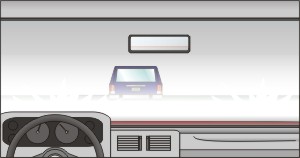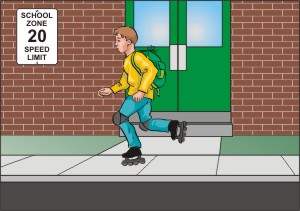As you travel the roadways in the state of Florida there are signs which state the "speed limit". These signs are the maximum limit allowed by law under ideal conditions. Some examples of when the speed limit may be too fast are as follows.
Environmental Hazards
Rain is one example, heavy rain reduces your ability to see and be seen. In the day time turn on your windshield wipers, low beam headlights and if needed your windshield defroster. Heavy rain at night can almost blind you. Doing the speed limit under those conditions is too fast. It is always best to reduce your speed limit in this scenario.
Fog also reduces your ability to judge distance. Oncoming vehicles may be closer than you think. Be alert and be prepared to slow down or you may need to pull off the pavement until conditions improve. Remember to turn on your emergency flashers to warn other drivers that you are stopped.
Dawn and dusk is another example of an environmental hazard. Try to make your car more visible during this period to others. Turn on your low beam headlights, not so that you can see better, but so that others can see you better.
Road Obstructions
Although expressways are built to keep traffic moving, conditions sometimes slow or halt traffic flow. One of these problems is highway construction. Watch for warning signs that are in place before you arrive at the area that is under construction. In section 8, you will see an example of those signs. The closer you get to the construction area the more you need to slow down and obey special speed limitations. Lighted sign boards and or cones may appear as you get closer to the construction area. These may reduce the number of traffic lanes. Check your mirrors and your blind spot before merging to be sure that the lane is clear. Trucks and other equipment may be using some or your entire traffic lane. Be aware of trucks pulling away from the area. They may leave mud or sand on the road. Slow down, steer gently and obey workers instructions. Be especially careful of workers and equipment operators that may not see you. Always use an extra space cushion to protect them.
Car Crash
An expressway crash may cause blockage of one or more lanes. When you see a problem ahead, check your mirrors for traffic behind you, flash your brake lights and slow down gradually. Watch for emergency personnel and police officers directing traffic. If you can go around the crash scene, proceed cautiously. Do not stop unless otherwise directed. Do not slow down to a crawl to look at the crash. You will only slow traffic and may even cause another crash.
Night Driving

Night driving brings on a new set of conditions that make the speed limit too fast for conditions. When driving at night, always drive with your headlights on. High beams will permit you to see further ahead, but only use them when there is no oncoming traffic for at least 500 feet and 300 feet if following another vehicle.
Use your low beam lights in bad weather. Use of your high beams in heavy rain or fog will reflect the light back into your eyes.
Some drivers do not realize that they have their bright lights on. If the oncoming driver does this, do not put on your bright lights. Slow down and glance down at the right edge of the road as a guide for your lane position. To avoid being blinded by the oncoming bright lights, do not stare directly into the oncoming lights.
Overdriving Your Headlights
Overdriving your headlights is driving at a speed that makes your stopping distance longer than the distance illuminated by your headlights.
School Zones

As a driver you must know what a school zone and a school crossing sign looks like. School zones will have signs indicating the hours of enforcement in addition to the school zone speed limit of a minimum speed of 15miles per hour or a maximum speed of 20 mph. These speed limits are strictly enforced for the safety of our children. The 15 mile per hour speed limit only applies when school is in session. Sometime the signage will be accompanied by a flashing yellow light. You may refer to section 8 for a listing of the signs.
School zones will present different conditions in the form of children walking, running or riding bicycles, school buses, vehicles driven by parents and school crossing guards. You must look at each child in a school zone as a human caution sign.
Caution - Fines for speeding violations are doubled in a school zone.
Construction Zones
Construction zones may utilize a combination of several different types of traffic management devices. You may encounter a flagman giving you instructions as to when to proceed safely or when to stop. You may also encounter signs, traffic cones or barricades with flashing yellow lights giving direction.
Very often the Department of Transportation will give you advance notice when they are going to be doing roadwork so that you may make alternative travel plans. However, if you do not get advance notification and you get caught in bad traffic, be patient, stay calm and stay within the speed limit. If you don't, the fine is doubled and that can get very costly quickly.
F.S.316.183 Unlawful Speed--
- No person shall drive a vehicle on a highway at a speed greater than is reasonable and prudent under the conditions and having regard to the actual and potential hazards then existing. In every event, speed shall be controlled as may be necessary to avoid colliding with any person, vehicle, or other conveyance or object on or entering the highway in compliance with legal requirements and the duty of all persons to use due care.
- On all streets or highways, the maximum speed limits for all vehicles must be 30 miles per hour in business or residence districts, and 55 miles per hour at any time in all other locations. However, with respect to a residence district, a county or municipality may set a maximum speed limit of 20 or 25 miles per hour on local streets and highways after an investigation determines that such a limit is reasonable. It is not necessary to conduct a separate investigation for each residence district. The minimum speed limit on all highways that comprise a part of the National System of Interstate and Defense Highways and have not fewer than four lanes is 50 miles per hour.
- No school bus shall exceed the posted speed limits, not to exceed 55 miles per hour at any time.
- The driver of every vehicle shall, consistent with the requirements of subsection (1), drive at an appropriately reduced speed when:
- Approaching and crossing an intersection or railway grade crossing.
- Approaching and going around a curve.
- Approaching the crest of a hill.
- Traveling upon any narrow or winding roadway.
- Any special hazard exists with respect to pedestrians or other traffic or by reason of weather or highway conditions.
- No person shall drive a motor vehicle at such a slow speed as to impede or block the normal and reasonable movement of traffic, except when reduced speed is necessary for safe operation or in compliance with law.
- No driver of a vehicle shall exceed the posted maximum speed limit in a work zone area.
- A violation of this section is a non-criminal traffic infraction, punishable as a moving violation as provided in Chapter 318.
No comments:
Post a Comment